skip to main |
skip to sidebar
On Saturday, 28th July 2018, I travelled to Hereford by rail, via Birmingham, to attend the 2018 'Lionsmeet' being held at Hereford Society of Model Engineers. The outward journey is described in the post here, the 'Lionsmeet' event is described here: this post describes my return.
Hereford-Wolverhampton
After I had attended 'Lionsmeet' during the day, John from the Hereford Society very kindly gave me a lift back to Hereford station. I had decided to return to Wolverhampton by a different route from the outward journey, by travelling to Shrewsbury on the former LMS/GWR Joint Line, there changing to a Wolverhampton train on the former GWR route. I'd previously travelled over the Hereford-Shrewsbury line on 26th July 2014 and described that trip in the post here.
In pre-grouping days, shown in the map below, five routes served Hereford but today Hereford is a just a through station on the Welsh Marches line from Crewe to Newport, plus the route I'd used to get to Hereford that morning which converges with the Welsh Marches line at Shelwick Junction, a couple of miles north of Hereford.
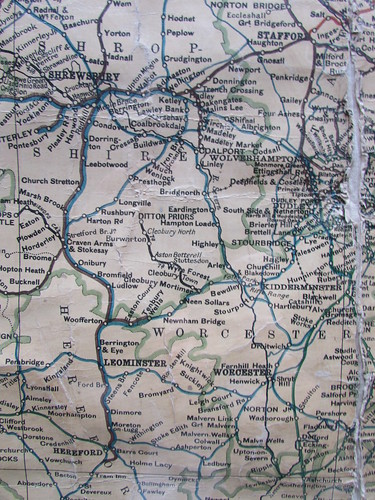
Pre-grouping railway map showing Hereford-Wolverhampton (W & A K Johnston, 'Railway Map of England and Wales 11th Edition').
Click for larger image
Waiting for the slightly late-running Manchester service which would take me to Shrewsbury gave me the opportunity to collect a few pictures around the station although intermittent rain made conditions less than ideal.
There are four roads through the station, two central Relief lines and two main lines, flanked by platforms. The Down platform (Southbound) has two faces and the outer face is used by terminating services from Birmingham. There is one signal box, south of the station on the Down side. Local points and shunting signals are mechanically operated, with power operation of more distant connections. Running signals are multiple aspect colour light.
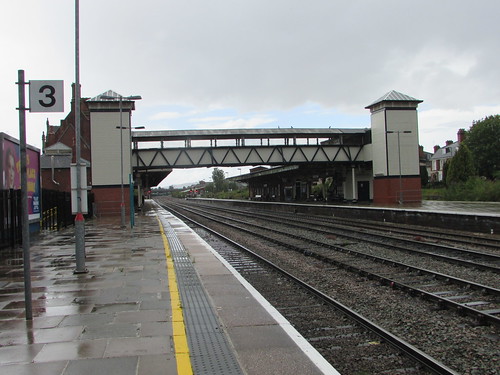
Hereford station 28th July 2018: Looking north from platform 3.
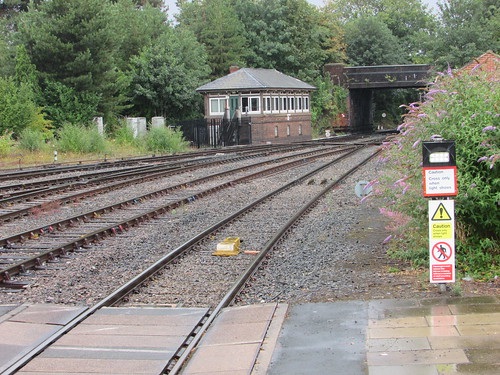 Hereford station 28th July 2018: Looking south from platform 3, showing signal box. Note barrow crossing, protected by lights.
Hereford station 28th July 2018: Looking south from platform 3, showing signal box. Note barrow crossing, protected by lights.
The 3-coach Arriva Trains Wales diesel multiple unit arrived, already fairly full, but I managed to find a seat. As we set off north in the rain I noticed, on the Up side, the remains of the two triangles which once served other railways converging on Hereford. In the early days of railway preservation, this area was home to the Bulmer's Railway Centre. Bulmer's established in Hereford in 1887 and I think were the largest cider maker in the world at one point. They are now owned by Heineken. In turn, we passed Shelwick Junction, Moreton-on-Lugg then the two single-bores of Dinmore Tunnel.
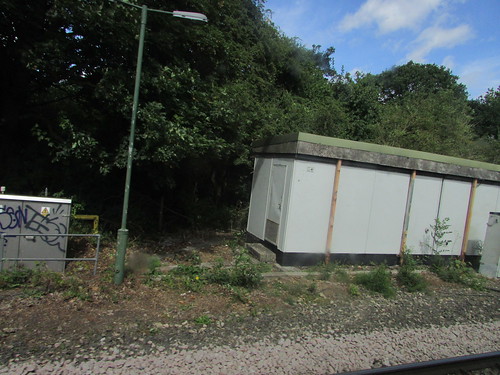
Shelwick Junction, Hereford, showing the signalling equipment room. 28th July 2018:
Just after Leominster signal box, we stopped at Leominster station. Once Leominster spawned at branch heading east to Worcester, south of the station and a second branch to the west, north of the station.

Hereford-Shrewsbury line, Leominster signal box, 28th July 2018.
I didn't even spot the site of Woofferton Junction, six miles beyond Leominster, where the branch to Tenbury Wells and Bewdley once diverged. Our next station stop was Ludlow and, seven miles further on, we paused at Craven Arms with its unattractive modern mechanical signal box.
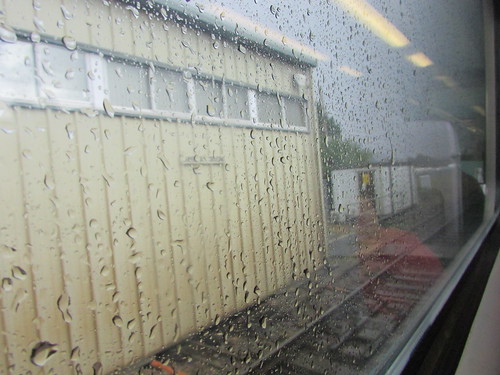
Hereford-Shrewsbury, Craven Arms Signal Box in the rain, 28th July 2018:
We made our stop at Church Stretton and then continued to Shrewsbury.
Twelve miles further on, we passed the standard Great Western design signal box at Sutton Bridge Junction, where the single Central Wales line diverges. The Great Western liked to dignify their signal boxes with a single, cast-iron name plate showing the name in full so I noticed the imposing length of the sign mounted on side facing the tracks reading 'SUTTON BRIDGE JUNCTION SIGNAL BOX'.
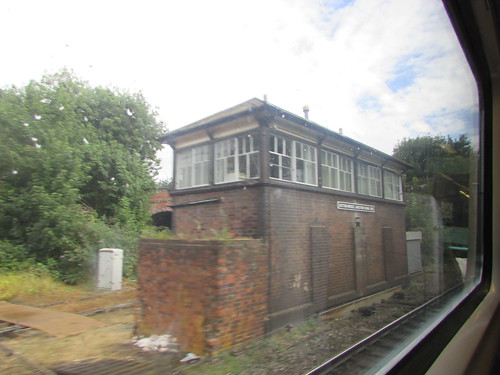
Shrewsbury area rail: Sutton Bridge Junction signal box, 28th July 2018.
The running signals at Sutton Bridge Junction are tubular post semaphore on a mixture of upper- and lower-quadrant patterns, all modified to feature better-protected access arrangements to meet modern Health and Safety requirements.

Shrewsbury area rail: Sutton Bridge Junction 2-doll Down Home, 28th July 2018.
We then passed the imposing bulk of Severn Bridge Junction which controls the south end of Shrewsbury station. This massive box always delights me because it is a London and North Western pattern construction (although, in my view, the original clean proportions have been marred by modern Health and Safety modifications).
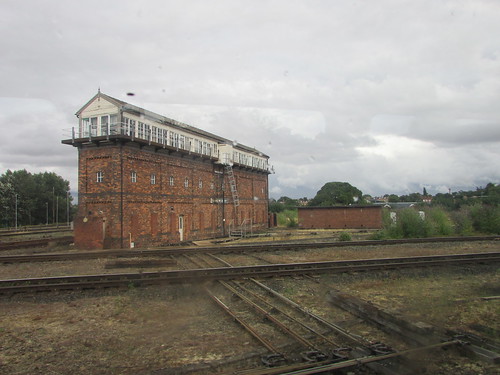 Shrewsbury area rail: Severn Bridge Junction signal box, 28th July 2018.
Shrewsbury area rail: Severn Bridge Junction signal box, 28th July 2018.
Severn Bridge Junction is now signalled by a haphazard collection of upper-quadrant semaphore, lower-quadrant semaphore and colour light signals!
At Shrewsbury, I changed to a Wolverhampton train (now operated by West Midlands Railway) after an interesting, but tiring, day.
Related articles on this site
To Hereford by rail.
A Trip to South Wales (Part 2).
Railways around Shrewsbury.
My pictures
Where necessary, clicking on an image above will display an 'uncropped' view or, alternately, pictures may be selected, viewed or downloaded, in various sizes, from one of the albums below:-
Shrewsbury-Hereford line.
Shrewsbury area railways.
Wolverhampton to Shrewsbury Line.
Wellington, ex-Great Western Railway.
West Midland Railways.
[Link to 'Lionsmeet' event added 26-Aug-2018]
On Saturday, 28th July 2018, I travelled to Hereford by rail to attend the 2018 'Lionsmeet' being held at Hereford Society of Model Engineers.
Wolverhampton-Hereford
I took a taxi to Wolverhampton (our bus service starts too late on a Saturday to be of help), a 'Virgin' London working to Birmingham New Street and then a 'West Midland Trains' service was supposed to take me to Hereford. The taxi worked, the short leg to Birmingham worked but the final segment proved 'interesting'.
I found the Class 172 Diesel Multiple Unit (DMU) which was to form the 08:50 to Hereford in platform 10. The unit was shut down and displaying a red tail lamp at each end but the Conductor had already arrived, opened the doors and passengers were boarding.
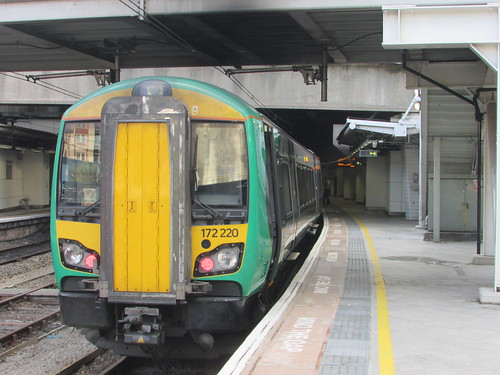
West Midland Railways: Birmingham New Street: Class 172 in platform 10, 28th July 2018.
The driver appeared, started the unit and we departed on time. The train slowly left New Street on the Down Gloucester line, passing through four tunnels (Holliday Street, Canal, Granville Street and Bath Row) before speed increased through Five Ways Station. We were due to stop at University Station, about two and a half miles from our starting point but suddenly the driver made a 'Full Service' brake application and we came to a rapid stop. 'What now?' I thought. I was sitting on the left (as I usually do, offering a limited view of passing signals) and could see no reason for our unscheduled halt. On the right of the train, clouds of smoke drifted by and passengers on that side started to take pictures with their mobile phones. Still puzzled, I got up, moved across and looked ahead on the right. I was quite started to see fierce flames on the heavily overgrown embankment.
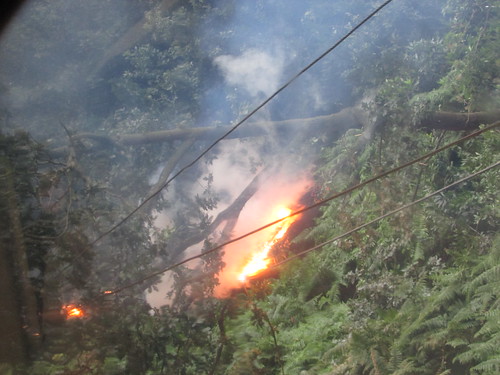
28th July 2018: Near University, a fallen tree on the embankment on the Up side had displaced the wires of the overhead traction system, producing a fairly spectacular fire.
The view from modern trains is not good and looking obliquely ahead through the double-glazed window unit was not ideal but it appeared that a tall tree on the embankment had fallen across the tracks and the return conductor, catenary wire and contact wire had all been pushed towards the ground by the weight of the tree. The main trunk was now horizontal, balanced across the overhead lines. The orange flames appeared to be the dry undergrowth burning but there was also a bright, white light in the fire suggesting that sustained arcing from the overhead system might still be occurring. As I watched the impressive display, there was a loud 'Whump', startling a number of passengers, and the white light ceased. I imagined this might be as the traction system finally 'tripped', or was intentionally discharged following a call on the radio from our driver. The orange flames continued and the young conductor announced that we were setting back a few yards to maintain a safe distance from the conflagration. The driver 'changed ends' and moved the train fifty yards or so back towards Birmingham New Street.
As we waited, I was impressed that, rather than resorting to the public address, the conductor worked his way through the 2-coach train advising passengers directly of his rather gloomy prediction that "we could be stuck here for hours". That seemed unduly pessimistic to me (we were only about two miles from Birmingham New Street Station) and, indeed, after perhaps ten minutes the conductor announced that we were returning to New Street. The driver set off 'wrong road' back the way we'd come but after a few hundred yards, an emergency crossover crossed us to the 'right road' and we continued under normal signalling back to New Street Station. We were were routed back into platform 10, where the colour light signal halfway along the platform beckoned us to the stop at the south end of the platform face. Birmingham New Street retains much of its complex network of approach routes, offering alternative ways of keeping trains moving when a line become unavailable. I anticipated that we'd continue our journey by taking the Up Derby as far as Grand Junction, diverging to St. Andrews Junction and then taking the Camp Hill line so as to regain our original route at Kings Norton. The Camp Hill line is not electrified, so that option was not available to the 'Cross City' service of Electrical Multiple Units (EMU) which provide a frequent commuter service to Longbridge and Redditch.

'Environs of Birmingham & Wolverhampton' from the 11th Edition of the Pre-Grouping 'Railway Map of England and Wales' published by W & A K Johnston.
Passengers who wanted stations to Kings Norton were advised to disembark and new passengers boarded. It was almost an hour since our initial departure so the new passengers had probably arrived for the next service. Still anxious not to give false hope to his passengers, the conductor announced that "at some point" our train would depart. Almost immediately, the signal cleared and the conductor ran to the 'back cab' to get the train away. As expected, we were routed to the Camp Hill line.
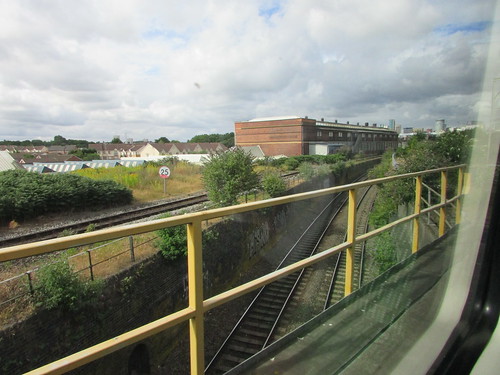
Flyunder near Grand Junction, Birmingham. L-R: Down Camp Hill, Down Derby, Up Derby, Up Camp Hill (on bridge), 28th July 2018.
At Kings Norton, we were back on the electrified route and each station we passed had an EMU waiting in the Up platform, unable to proceed further towards Birmingham until the catenary damage near University Station had been addressed.
I'd not been following the saga of the extension of electrification from Barnt Green (where the single-line branch to Redditch diverges), down the famous Lickey Incline to a new enlarged, remodelled and resignalled station at Bromsgrove. This was to have been completed in 2014 and the new 4-platform station certainly looked impressive. I discovered afterwards that the new, improved electric services were to start the very next day - Sunday 29th July 2018 - a mere four years late!
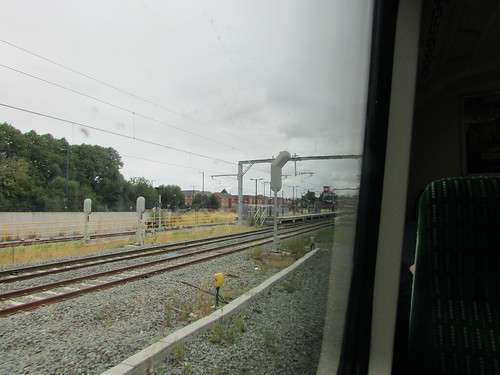
South end of the remodelled Bromsgrove station: 28th July 2018:
Two miles beyond Bromsgrove, we diverged right at Stoke Works Junction and, after four miles of single track, joined the double-track line from Kidderminster at Droitwich Spa Junction. Lower quadrant signals and a standard GWR design signal box (albeit with modern alterations) confirmed that we were now on former Great Western lines.
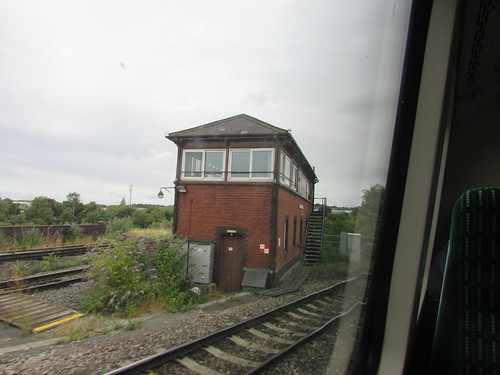
Worcester Area Rail: Droitwich Spa signal box 28th July 2018
As we continued our journey, the conductor announced that his Control had informed him that our late-running service would now terminate at Great Malvern and that passengers for stations beyond there should de-train at Worcester Foregate Street where road transport onwards would be made available. On our modern railway system (which a member of the Rail Delivery Group recently had the temerity to describe as "the envy of Europe") passengers, who are now called 'customers', are casually treated with contempt. Although the original reason for delay was unfortunate (although probably avoidable with better arrangements for periodic lineside inspection and maintenance), Control's concern was to seek to get the unit and crew back onto their scheduled 'diagram', by turning the train around short of its destination. The inconvenience to passengers didn't seem to feature in their calculations, as we discovered on our arrival at Worcester Foregate Street where station staff confirmed that there was no onwards road transport and we should simply wait for a following train to Hereford.
Since the following train was also running late, I had time to take some photographs around the station. Although at first sight it appears a conventional 2-track station with flanking platforms, the two lines form the southern apex of a triangle and two elderly, wooden, hand-painted signs at the southern ends of the platforms warn:-
CAUTION
TWO-WAY
working on
BOTH LINES
I assumed that the mix of upper and lower case was to fit the message in the available space.
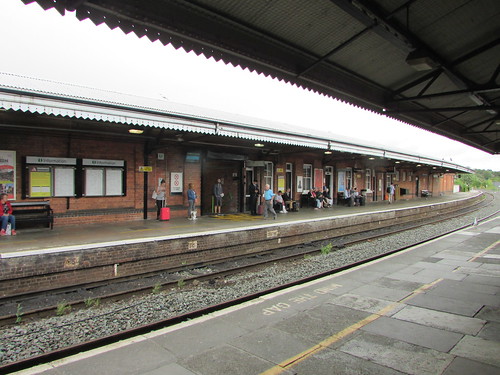
Worcester Area Rail: View from Worcester Foregate Street Platform 1 looking towards Rainbow Hill Junction, 28th July 2018.
Eventually, the following train for Hereford arrived, loaded up and set off southwards, passing over Foregate Street bridge which gives the station its name. The two parallel single lines are then carried over the 935 yard Worcester Viaduct and the River Severn before crossovers at Henwick Level Crossing signal box restore normal Up and Down running through Malvern Link and Great Malvern stations.
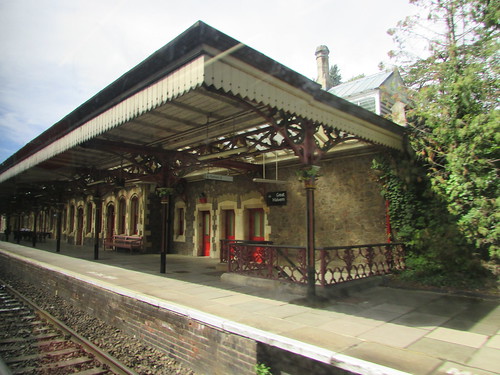 Worcester Area Rail: Great Malvern station Up platform, 28th July 2018.
Worcester Area Rail: Great Malvern station Up platform, 28th July 2018.
About one mile beyond Great Malvern station, at Malvern Wells signal box, the line singles through Colwall Tunnel (1536 yards) and Colwall station. After Ledbury Tunnel (1316 yards), Ledbury station has a passing loop but becomes single again before crossing over the 372 yard Ledbury Viaduct. Another 12 miles of single track leads to Shelwick Junction on the double-track Shrewsbury-Hereford Line. This junction is now remotely-controlled from Hereford, about 2-miles further on. My arrival at Hereford was 86 minutes late.
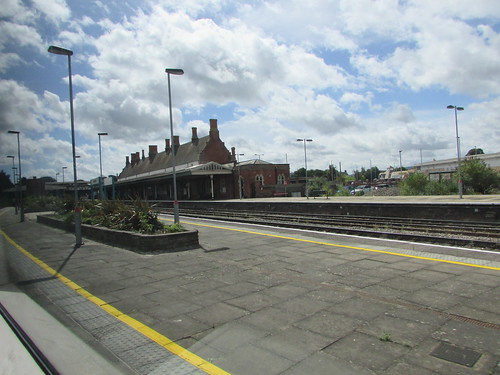
Hereford station buildings viewed from platform 1: 28th July 2018.
The 'Lionsmeet' event is described in the post here.
My return rail journey, via Shrewsbury, is described in the post here.
My pictures
Where necessary, clicking on an image above will display an 'uncropped' view or, alternately, pictures may be selected, viewed or downloaded, in various sizes, from one of the albums below:-
West Midland Railways.
Worcester Area Rail.
Shrewsbury-Hereford line (includes more pictures of Hereford station).
[Link to return journey added 11-Aug-2018, link to 'Lionsmeet' post added 26-Aug-2018]
One of the joys of property owning is the recurrent need for repairs. This is particularly the case with a building dating from 1640 which is also Listed Grade II. From time to time, I review some of the work carried out.
I think the first post describing external repairs covered 2014 and is here.
2016
Prior to the Garden Party at Brewood Hall in 2016 (described in the post here) repairs were carried out on the garden paths at the front of Brewood Hall. Work started with the delivery of materials by a large lorry equipped with a remotely-controlled self loading/unloading hydraulic crane.

Path repairs at Brewood Hall: OCL lorry (with a remotely-controlled self-loading/unloading hydraulic crane) delivering materials.
A couple of days later, a large skip was delivered to carry away spoil from the repairs.

Path repairs at Brewood Hall: Delivery of a large skip to carry away spoil.
The paths at the front of the building were relaid by Jim and Pete from A. M. Griffiths, together with Dave who has looked after the gardens (extending to about one acre) for some years.
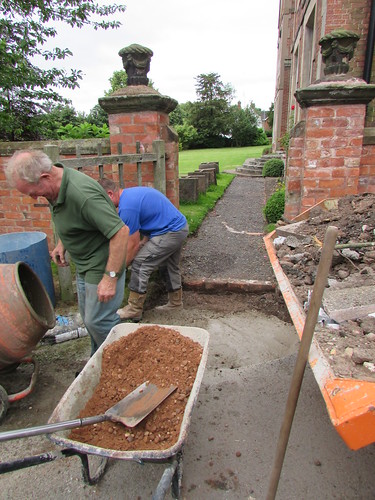
Path repairs at Brewood Hall in 2016.
2017
During 2017, improvements were carried out to the path at the rear of the building where damaged stone slabs were replaced by reclaimed paviours to better match the paved area outside the kitchen and the small barn. Further work will eventually improve the adjacent decorative cobbled area.
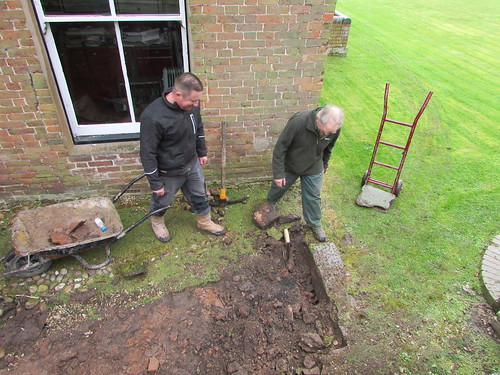
Brewood Hall: Jim and Dave working on repairs to path at rear.
To gain access to the front elevation allowing repairs to the decorative cement quoins, a 'Genie' Self-Propelled Articulating Boom Z-45/25 was hired in. Whilst the machine was on site, some high-level repointing of brickwork was also carried out. It was an amazing machine and I took some pictures from an elevated position. The work was completed prior to the Brewood Garden Party in 2017 (described in the post here).
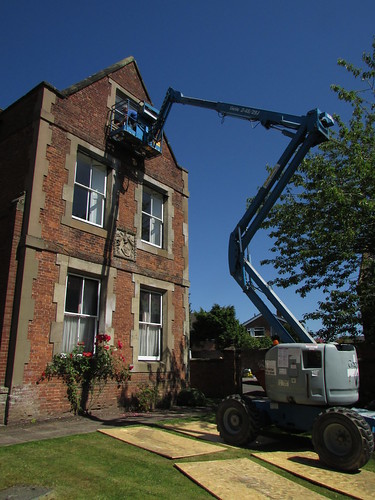
Repairs at Brewood Hall: 'Genie' Self-Propelled Articulating Boom Z-45/25
In November 2017 I visited Cawarden Brick and Tile Reclamation Yard near Rugeley with Brendan where we obtained sufficient reclaimed Staffordshire Blue Edgers for the front path which Dave later installed.
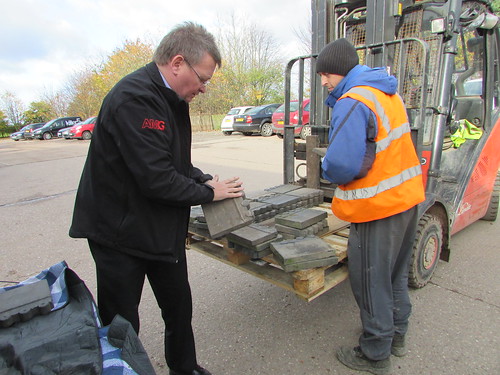
Cawarden Brick and Tile Reclamation Yard: Brendan inspecting reclaimed edgers.

Brewood Hall Garden 2018: Reclaimed edging installed adjacent to the front path.
Related posts on this website
Brewood Hall Maintenance.
Brewood Hall Tree Maintenance.
To see all my posts on Brewood Hall, select Label 'Brewood Hall' or click here.
My Pictures
Where necessary, clicking on an image above will display an 'uncropped' view or, alternately, pictures from may be selected, viewed or downloaded, in various sizes, from the album below:-
Repairs at Brewood Hall.
Reclamation Yard.
Brewood Hall garden has a number of trees. Just as the Hall itself, a Listed Building, requires maintenance the trees also require periodic inspection and attention. The situation is complicated because all the trees are within the Brewood Conservation Area.
In 2012 a group of oak trees along one boundary were pruned for the second time and this is described in the post here.
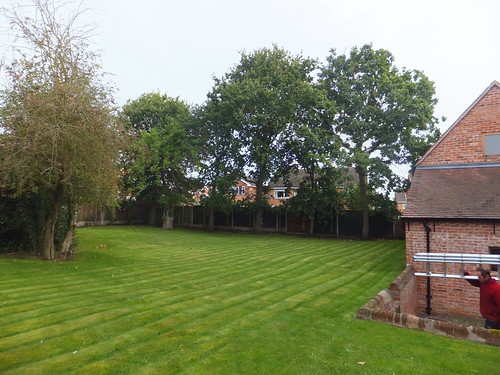
Oak Tree Pruning at Brewood
In September 2014, a self-set sycamore very near the front garden wall had to be felled. It had grown so as to threaten to demolish the garden wall. Although I'm not keen on sycamore, I'd given it a chance to grow clear of the wall but, of course. it didn't oblige. With a chain saw and an expert bit of rope work, Rik and Dave safely brought down the main trunk across the front lawn before quickly reducing the tree to a series of 'rounds'.

Sycamore felling at Brewood Hall, with Dave on the rope.

Sycamore felling at Brewood Hall: The felled tree reduced to a series of 'rounds'.
In contrast, I find silver birch attractive. My partner had planted one near the front gates in the 1980s as a replacement for a much older silver birch nearby which had been well-established when I came to Brewood in 1971 but had since died. The replacement tree lasted until 2017 when inspection showed that it was in danger of collapse so, reluctantly, I agreed to felling and Rik and Dave promptly carried out the work on 25th October 2017.
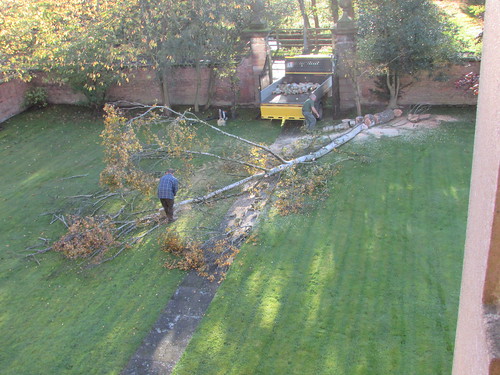
Tree felling at Brewood Hall: This view shows the height of the felled tree.
Related posts on this website
Oak Tree Pruning at Brewood Hall
My Pictures
Where necessary, clicking on an image above will display an 'uncropped' view or, alternately, pictures from may be selected, viewed or downloaded, in various sizes, from the album below:-
Oak Tree Pruning at Brewood.
Brewood Hall: Sycamore felling.
Felling of dying silver birch.
Even casual perusal of this blog is likely to reveal my enthusiasm for driving steam locomotives, latterly at a couple of preserved railways in the United Kingdom. At the Battlefield Line, I also drive the Diesel Multiple Units (DMU) owned by Ritchie Marcus and there's a steadily-increasing number of posts describing this (you can find them all here or by selecting 'DMU' from the list in 'Labels to select a blog topic').
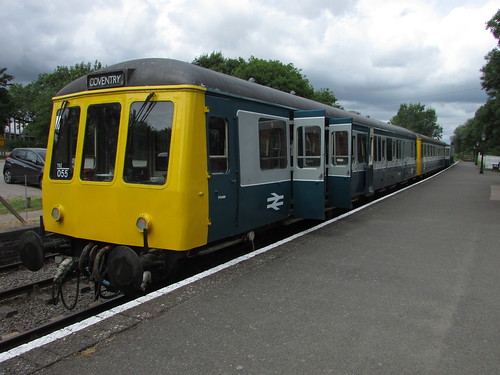
DMU Days at the Battlefield Line: After taking the school party to Shenton on 4th July 2017, the 1-car coupled to the 2-car set wait at Shenton prior to the return to Shackerstone.
In the summer of 2018, these diesel railcars provide the 'Midweek Services' on Tuesdays, Wednesdays and Thursdays so I seem to be getting regular DMU driving turns. I've always enjoyed driving the 'British Railways Modernisation' DMUs, which I remember from my own childhood when they were first introduced but the afflictions of increasing age make a 'diesel day' increasingly attractive for a number of reasons.
Firstly, preparation time is much reduced, compared with steam. 'Checking levels', as on a car, is required but the laborious 'oiling round' is avoided. Whilst a visual examination around the underframe is essential, once the engines are started, also from ground level, the driver can return to the cab whilst the compressors establish sufficient control air pressure to allow movement.
Secondly, driving is carried out whilst seated. Whilst I don't find the seat design particularly good (and manoeuvring around it is tight), it represents luxury compared with most steam locomotives which either make no provision for sitting or offer a rather mean wooden tip-up seat. Gresley is renowned for fitting a padded leather bucket seat on some of his steam locomotives. On most designs, many drivers (the writer included) preferred to remain standing to make the most of the poor forward vision offered by the cab design.
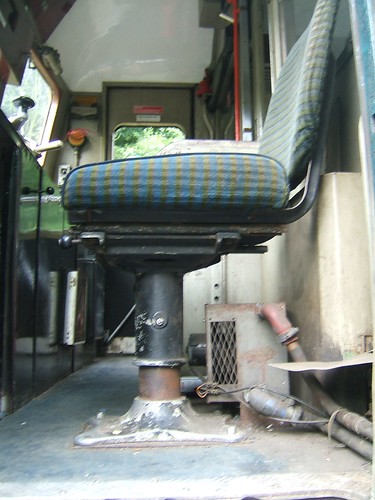
Detail of the driver's adjustable seat.
I often say '90% of a driver's attention should be focussed on the line ahead'. We can debate the exact percentage but keeping a good lookout is vitally important. The windows across the full width of the DMU cab give a panoramic view down the line very welcome to steam drivers brought up on leaning out of the cab to get reasonable sightlines around the front of the boiler. Provided the blinds at the rear of the DMU cab are raised, the passengers, too, can enjoy the view of the route ahead. The blinds were provided, of course, for use at night when the lights in the passenger compartment would otherwise damage the driver's night vision. More modern designs of diesel railcar reverted to solid walls between passengers and cab.
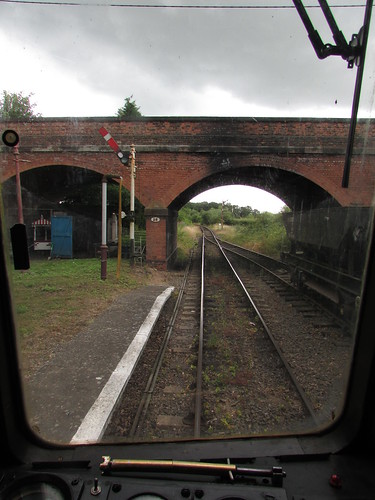
DMU Days at the Battlefield Line: Driver's view leaving Market Bosworth for Shackerstone.
On a steam-hauled train, to give the driver any chance of watching the line ahead, it's a requirement that the locomotive is a the front of the train (except where special arrangements are made called 'push-pull' or 'auto' trains). This means that, at each and of the line, there's a period of furious activity where the locomotive is uncoupled from the coaches, shunted to the other end of the train and re-coupled. On DMU, a driving cab is provided at each end of the train so that, at the end of the line, it's only necessary for the driver to 'close' what had been the leading cab, move to the other end of the train and 'open' what had been the 'back cab' so as to become the leading cab. The business of 'closing' and 'opening' cabs involves the transfer of an electrical master key and removable handles to control the final drive and braking systems.
Although the supply of coal carried by a steam locomotive is normally arranged to suffice for a whole day, the water supply (which is boiled to produce steam, used to impel a piston up and down a cylinder producing useful work and then discharged as exhaust steam from the chimney) often requires replenishment a number of times a day. By contrast, a DMU may be able to run for a number of days before the diesel fuel tanks require topping-up and water (used to cool the diesel engines, as in a car) is recirculated.
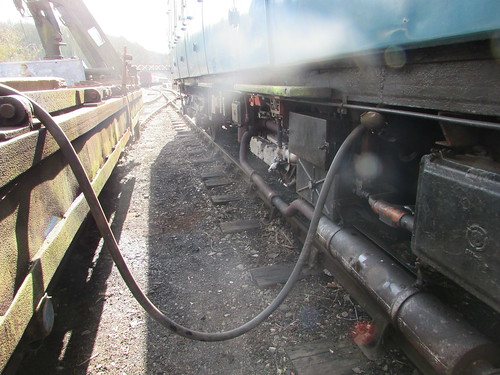 Refuelling the DMU at Shackerstone.
Refuelling the DMU at Shackerstone.
On a DMU, the driving controls, instruments and indications are laid out on the desk in front of the driver in a reasonably ergonomic manner unheard of on steam locomotives although Riddles, in designing the British Railways 'Standard' steam locomotives, attempted a convenient layout.

The driving controls, instruments and indications are neatly laid out on the desk in front of the driver.
Drivers also appreciated the 'power on demand' nature of the DMU. With steam traction, the power available to work the train depended upon many factors including time since last 'shopping', time since last boiler washout, quality of coal and, not least, attitude and competence of the fireman. In contrast, a DMU normally works as intended or doesn't work at all. That's a bit of a simplification but, in general, when a diesel driver opens the throttle, the power will flow, giving the driver a feeling of confidence that the job will go well.
But perhaps the best feature of working on a DMU is the opportunity to meet passengers. Many passengers seek out a seat in the leading coach where they can see the line ahead and watch the driver at work. In stations, passengers (men, ladies and children) can often be seen studying the cab and may ask questions. When working on steam, although we always try to acknowledge anyone nearby, the workload involved hinted at above means that a protracted chat is rarely possible. In contrast, when working on a DMU there are better opportunities for passengers to take photographs of the driver's 'office' or to answer questions (admittedly at the risk of boring them to tears - 'too much information'). I never cease to be amazed at the interesting backgrounds and experiences of our visitors. And, at the end of the day, I'm not quite as shattered (or dirty) as after a steam 'turn'.
On Saturday, 7th July 2018, the Brewood Garden Party was held, for the sixth time, in the garden at Brewood Hall. The event is organised by 2nd Brewood Scouts, Brewood Parish Church and the informal group Friends of Brewood Hall. All of the work organising and running the event is carried out by volunteers.
Preparations
As in previous years, there was an organising committee who met a number of times in the months prior to the event to ensure that visitors enjoyed their visit on the day. 'Flyers' had been distributed around the village, posters and a banner had been put up and there were announcements on social media. Erection of the tents and stalls was started on the evening of Friday, 6th July, using a different layout to previous years which proved popular.

Brewood Garden Party 2018: Setting-up on Friday: Methodical erection of the craft marquee.
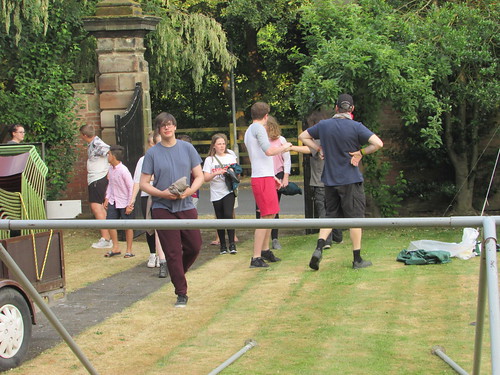
Brewood Garden Party 2018: Setting-up on Friday: Welcome reinforcements!
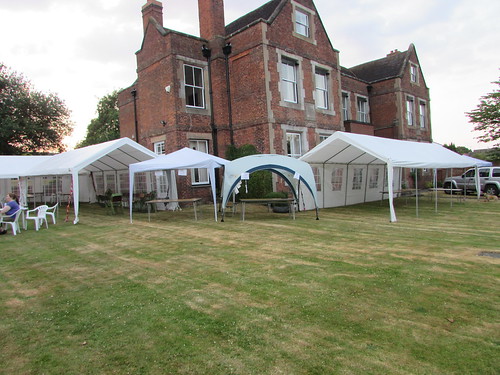 Brewood Garden Party 2018: Setting-up on Friday. L-R: Band tent, Pimm's Tent, Tombola tent, Craft Tent.
Brewood Garden Party 2018: Setting-up on Friday. L-R: Band tent, Pimm's Tent, Tombola tent, Craft Tent.
Setting-up was completed on Saturday morning, following an early start, so as to be ready for the opening at noon.
The Event
The whole week had been warm and Saturday was the same. All the usual stalls and diversions were provided, plus some innovations.

Brewood Garden Party 2018: Admission desk at front gates.
The Staffordshire Corps of Drums opened the proceedings with an impressive display. They admitted that, in the heat, the woollen uniforms were very uncomfortable.
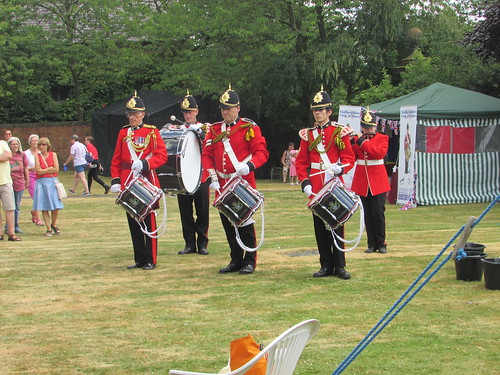
Brewood Garden Party 2018: The Staffordshire Corps of Drums opened the proceedings.
The Refreshment Tent quickly became busy and remained busy. This year, the local Midland Counties Co-op store provided additional help which was very welcome.
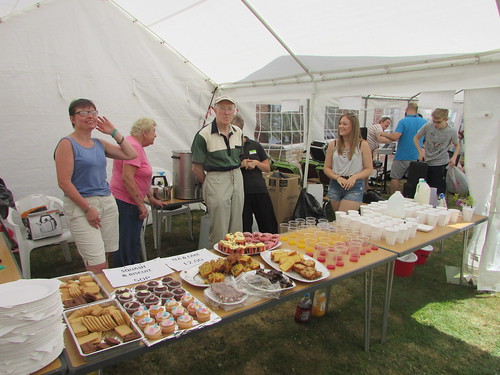
Brewood Garden Party 2018: A wide range of snacks were available in the popular Refreshment Tent.
For the first time, local traditional butchers Maiden's offered hot dogs, burgers and frozen snacks.

Brewood Garden Party 2018: Maiden's ready for business.
The Pimm's Tent, Tombola and Plants and Produce stall remained popular.
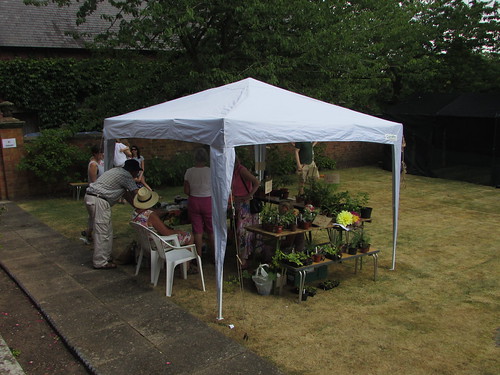
Brewood Garden Party 2018: Plants and Produce Stall.
The Craft Tent featured the work of a number of local artists and crafters.

Brewood Garden Party 2018: Jan with local artist Rob.
Black Country Live Steamers appeared again with two immaculate miniature traction engines and, located in the driveway, were able to give rides.
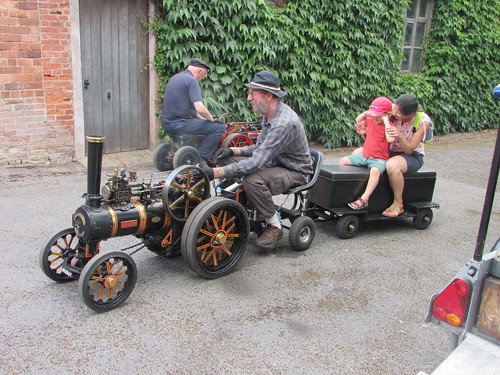
Brewood Garden Party 2018: Miniature traction engines from Black Country Live Steamers.
Chase Ferret Rescue were appearing for the first time. They had brought a number of ferrets and everybody was most impressed by the quality of the accommodation provided for the ferrets and the knowledge and care displayed by their volunteers.

Brewood Garden Party 2018: The Ferret Rescue stand.
I'd never handled ferrets before and I admit I was entranced by the creatures.

Brewood Garden Party 2018: Jan makes friends with a young ferret.
To appeal to our younger visitors, we had the Coconut Shy, Catapult Range and Wet Sponge Throwing together with the supervised Kids' Under-5 Zone.

Brewood Garden Party 2018: A busy time at the Kids' Under-5 Zone.
A new attraction in 2018 for children was the Toys and Sweets stall.
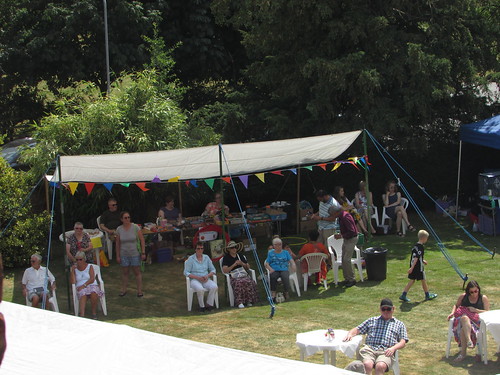
Brewood Garden Party 2018: View of Toys and Sweets Stall which also provided welcome shade to some visitors.
Later in the afternoon, there were Egg and Spoon and Sack Races.

Brewood Garden Party 2018: Childrens' Sack Race.
Everyone was delighted that, once again, the Cannock Bands, based at the Cannock Performing Arts Centre, returned to play for us.

Brewood Garden Party 2018: Cannock Wind Band performing. Because of the heat, they were not in their customary black uniforms.
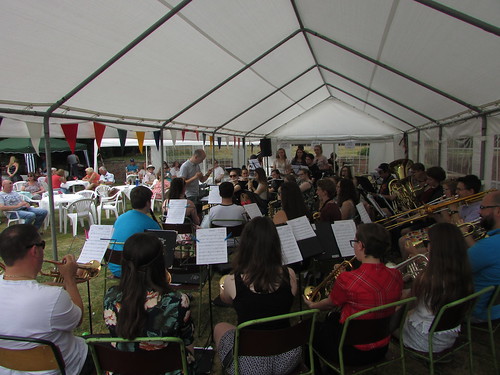
Brewood Garden Party 2018: Cannock Big Band performing: The view looking towards the audience.
Finally, the Staffordshire Corps of Drums gave a second display.

Brewood Garden Party 2018: A second performance by the Staffordshire Corps of Drums.
In choosing the date for this year's garden party, the organising committee were faced with the difficult problem of trying to avoid competing attractions. What they could not have known was that the English football team would achieve a measure of success in the World Cup being played in Russia, resulting in the team having a match starting at 3.00 p.m. on the day of the garden party. A mass early exodus was anticipated with people seeking to watch the match on television. The timing of the band performances at the garden party was brought forward to help and the Scouts brought their 50-inch plasma television. This was set up in the band tent (after the band performances) and hooked-up to the Brewood Hall aerial system, allowing people to remain on site and watch the game!
England lost in their World Cup match but lots of people confirmed that the Brewood garden party had been a splendid event.
Reports on earlier garden parties at Brewood Hall
Brewood Vintage Garden Party 2013.
Brewood Vintage Garden Party 2014.
Brewood Garden Party 2015.
Brewood Garden Party 2016.
Brewood Garden Party 2017.
Pictures of the event
Where necessary, clicking on an image above will display an 'uncropped' view or, alternately, pictures from may be selected, viewed or downloaded, in various sizes, from the album below:-
Brewood Garden Party 2018.


 Hereford station 28th July 2018: Looking south from platform 3, showing signal box. Note barrow crossing, protected by lights.
Hereford station 28th July 2018: Looking south from platform 3, showing signal box. Note barrow crossing, protected by lights.





 Shrewsbury area rail: Severn Bridge Junction signal box, 28th July 2018.
Shrewsbury area rail: Severn Bridge Junction signal box, 28th July 2018.











































